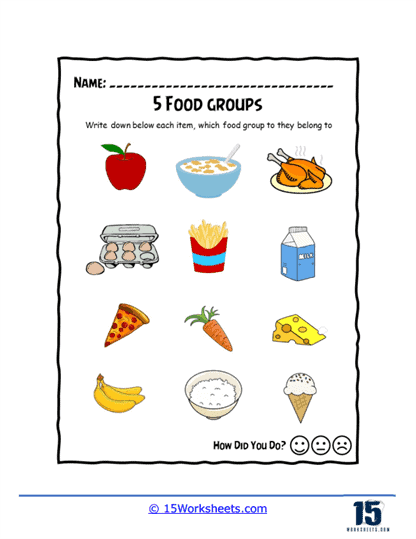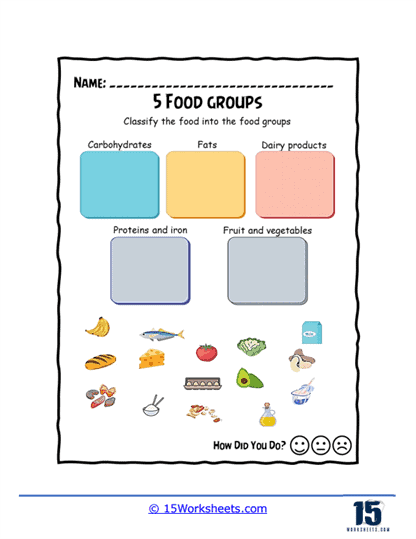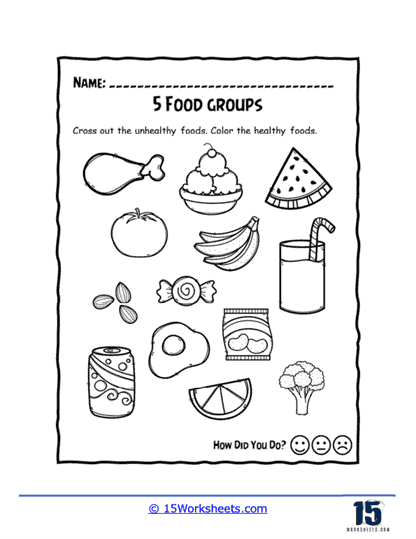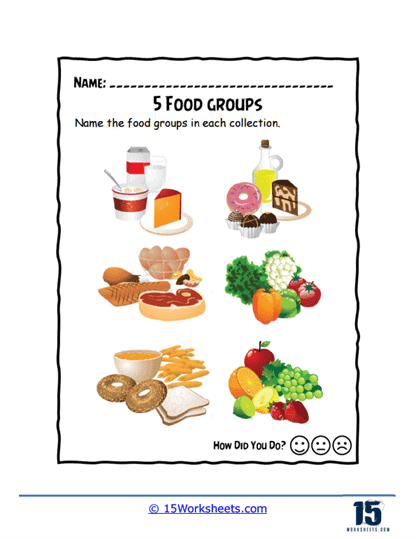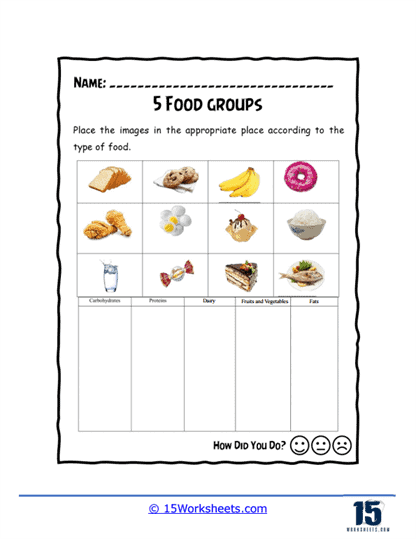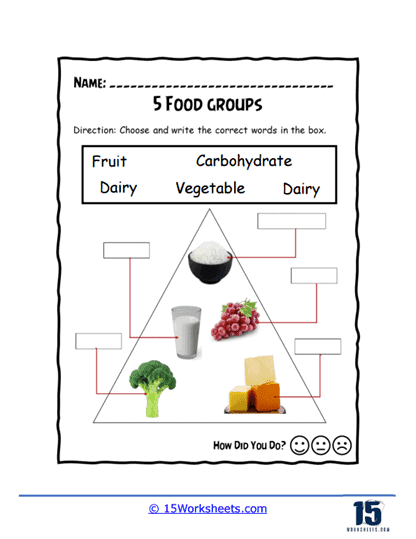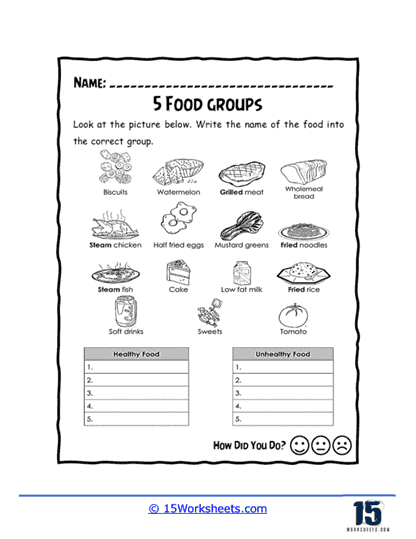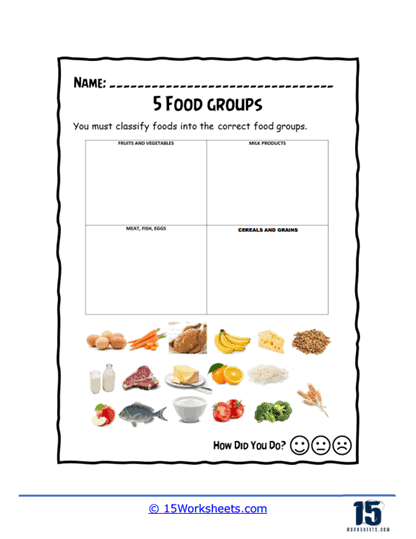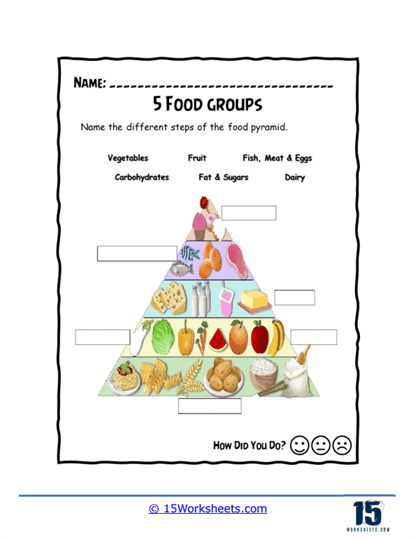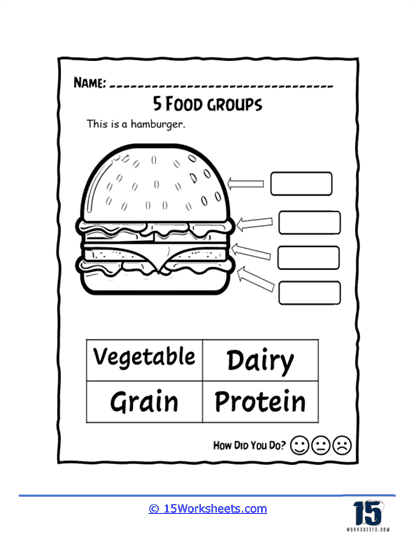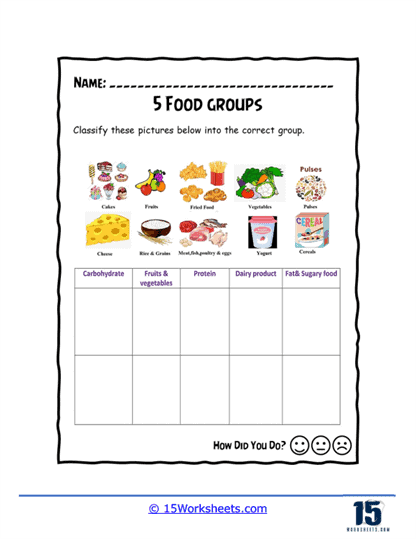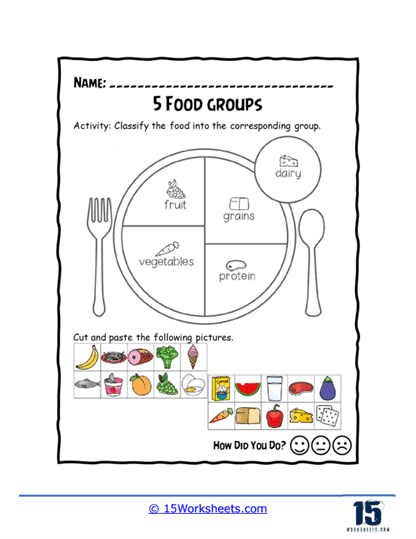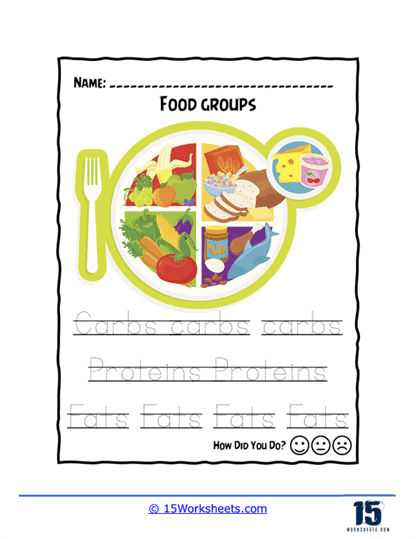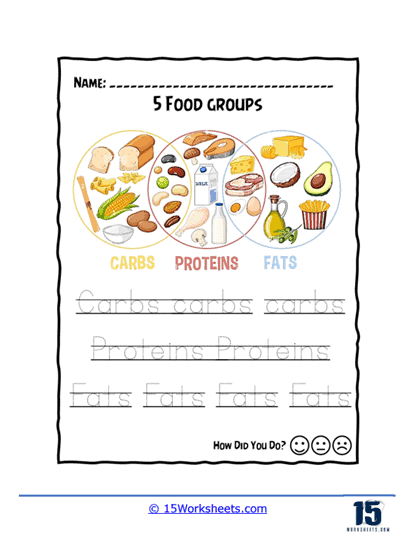Food Groups Worksheets
All About These 15 Worksheets
Introducing young learners to the concept of food groups is an essential step toward cultivating healthy eating habits that can last a lifetime. The “Food Groups” worksheet series is thoughtfully designed to immerse students in the world of nutrition, providing them with the tools they need to recognize the importance of balanced eating. Through a range of interactive and hands-on activities, these worksheets go beyond mere food identification; they foster critical thinking, creativity, and the development of essential life skills that children will carry into adulthood.
Each worksheet invites students to engage actively with the material, transforming learning into an enjoyable and memorable experience. Children are not only identifying foods but also categorizing them, learning to distinguish between healthy and unhealthy options, and building their vocabulary through context-rich exercises. These activities are purposefully designed to address multiple areas of learning simultaneously-enhancing language skills, boosting cognitive development, and promoting an understanding of nutrition that will serve as the foundation for lifelong health.
Hands-On Learning
One of the most powerful aspects of our food groups worksheets is their ability to encourage hands-on learning. Rather than passively absorbing information, students are invited to interact directly with the content. For instance, in activities where children must write down the names of foods based on pictures and identify their corresponding food groups, they are engaging in a multi-step process. First, they must visually recognize the food item, connect it with its name, and finally place it within the appropriate category. This type of learning reinforces not only vocabulary but also the understanding of how various foods contribute to a balanced diet.
This categorization task also plays a key role in promoting critical thinking. By classifying foods into their respective groups, students begin to see the bigger picture of nutrition-how fruits, vegetables, grains, proteins, and dairy all contribute to a healthy meal. These exercises help children develop a sense of structure and organization in their thinking, which is crucial not just for understanding nutrition, but for all areas of learning. They begin to recognize patterns and associations, skills that will help them in subjects ranging from science to mathematics.
Building Awareness Through Visual Discrimination
In a world where unhealthy food choices are often more visually appealing, teaching children to differentiate between nutritious and non-nutritious options is more important than ever. The worksheets encourage students to identify and cross out unhealthy food items while coloring in the healthy ones. This activity taps into their natural love of coloring while instilling a critical skill: visual discrimination. Students learn to observe closely, make judgments, and take an active role in choosing what is best for their health.
This seemingly simple task carries deeper implications. As children learn to recognize the difference between healthy and unhealthy foods, they are simultaneously developing an awareness of how these choices affect their bodies. This fosters a sense of responsibility over their own health and well-being, empowering them to make nutritious choices even outside the classroom.
Creative Expression Meets Nutrition Education
The creative exercises within the “Food Groups” worksheets go beyond the ordinary. For example, when students are asked to draw a food item that fits within each food group, they are given the opportunity to express their creativity while reinforcing their knowledge of nutrition. This activity serves multiple purposes-it allows children to internalize the information they’ve learned by translating it into a visual representation, and it also gives them the freedom to use their imagination in a constructive way.
Creative tasks like drawing food items also encourage self-confidence in young learners. When children complete an artistic task that demonstrates their understanding, they gain a sense of accomplishment. This confidence can extend to other areas of learning, as students begin to see themselves as capable problem-solvers and critical thinkers.
Reinforcing Knowledge Through Repetition and Application
The worksheets are designed with repetition in mind, a vital element of learning. As students are repeatedly exposed to the names, images, and categories of food groups, they strengthen their retention of this information. Tracing the names of different food groups, for instance, not only helps children practice their letter formation and fine motor skills but also reinforces their vocabulary in a way that is tactile and engaging.
By labeling and naming the sections of the food pyramid, students consolidate their understanding of the proportions of each food group in a balanced diet. This repetitive engagement with the material helps solidify their knowledge, ensuring that these concepts become second nature to them as they grow.
Bringing It All Together
Perhaps one of the most enriching aspects of this series is how it ties together different modes of learning. By engaging students in writing, drawing, coloring, and classifying, the worksheets cater to various learning styles, ensuring that each child can find a point of connection with the material. Whether a student learns best through visual cues, hands-on activities, or verbal engagement, these worksheets provide multiple pathways to understanding.
The holistic approach these worksheets take extends beyond cognitive skills. They nurture a sense of well-being in students by emphasizing the importance of balanced nutrition as part of a healthy lifestyle. As children learn about the food groups found in everyday items, such as a hamburger, they begin to view food in a more thoughtful way, understanding that each meal can offer a range of nutrients. This awareness promotes not just knowledge but also an appreciation for the choices they make about what they eat.
The goal of these worksheets is to instill a deep understanding of and appreciation for healthy eating. These worksheets are more than just educational tools-they are stepping stones to building lifelong habits. By engaging young learners in activities that promote critical thinking, creativity, and hands-on exploration, we are setting the stage for a future in which children can make informed, nutritious choices for themselves and their families.
What Are the Five Food Groups?
Have you ever looked at your lunch or dinner plate and wondered why it’s filled with so many different types of food? Why can’t we just eat our favorite pizza or ice cream all the time? Well, that’s because our body is like a supercar-it needs different types of fuel to run smoothly and powerfully. These different types of fuel are provided by the five food groups. Let’s discover what these groups are and why each one is essential.
1. Fruits
Fruits are nature’s candy, filled with sweet deliciousness. But they’re not just yummy. Fruits are power-packed with essential nutrients like Vitamin C, which keeps our skin healthy, and fiber that helps our tummy stay happy.
Fruits come in all shapes, colors, and sizes: tiny blueberries, juicy oranges, sweet bananas, crunchy apples, and water-filled watermelons. They can be enjoyed fresh, frozen, canned, or even dried. Remember, though, it’s best to eat whole fruits instead of drinking fruit juice, which can have a lot of added sugar.
2. Vegetables
Vegetables may not be everyone’s favorite, but they’re super important for our bodies. They’re loaded with vitamins, minerals, and fiber, which keep our bodies growing strong and help us fight against germs.
There are so many vegetables to choose from: leafy greens like spinach and kale, crunchy carrots and cucumbers, bell peppers that come in a rainbow of colors, and even sweet potatoes. Just like fruits, veggies can be eaten fresh, canned, or frozen, and even drunk as juice. The more colors on your plate, the better!
3. Grains
Imagine your body is a car again. If fruits and vegetables are like the oil and water in your car, grains are like the gas-they keep your engine running by giving you energy. Grains also have fiber, which helps digestion, and B vitamins, which help your body use the energy from food.
Grains include foods like bread, cereal, rice, and pasta. But not all grains are created equal! Try to choose whole grains like brown rice, whole wheat bread, or oatmeal because they have more fiber and nutrients than refined grains like white rice or white bread.
4. Protein
Protein foods are like the building blocks for your body-they help build and repair your muscles and tissues. They also help your body fight against germs and make important chemicals your body needs.
There’s a wide variety of tasty protein foods to pick from. Animal sources include meat like chicken, turkey, beef, and fish. But there are also plenty of plant-based proteins like beans, lentils, tofu, and nuts. Eggs and cheese are good protein sources, too!
5. Dairy
Dairy products, or foods made from milk, help build strong and healthy bones and teeth. That’s because they’re an excellent source of calcium and Vitamin D.
Common dairy foods include milk, cheese, and yogurt. If you can’t have dairy, don’t worry! There are plenty of other foods fortified with calcium and Vitamin D, like almond milk, soy milk, or even orange juice.
The Colorful Plate
So, why do we need to eat from all these different groups? It’s because no single food group can provide all the nutrients our body needs. It’s like building a house-just as you need bricks, cement, wood, and tiles, our body needs nutrients from all five food groups to grow and stay healthy.
When you sit down for a meal, picture your plate as a rainbow-each color represents a different food group. The more colors you see, the more balanced your meal is. And don’t forget, while it’s crucial to have a mix, it’s also important to pay attention to portion sizes to make sure you’re not eating too much of one food group.

